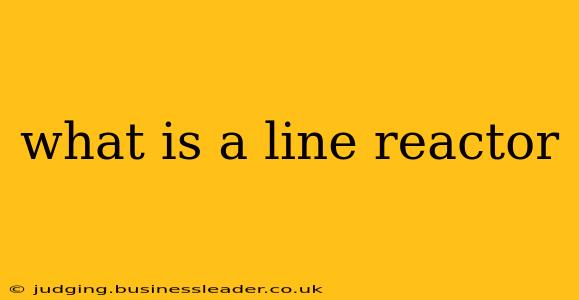A line reactor, also known as a reactor coil or simply a reactor, is a passive electrical component used in power systems to limit the flow of short-circuit currents and harmonic currents. It's essentially an inductor, a coil of wire that stores energy in a magnetic field, strategically placed within a power system's network. Its primary function is to improve power quality and protect equipment from damaging surges.
How Does a Line Reactor Work?
Line reactors work based on the principle of inductance. When an alternating current (AC) flows through the reactor, it generates a magnetic field. This magnetic field opposes changes in current flow, acting as a current-limiting device. The higher the inductance of the reactor, the greater its ability to impede current changes.
This opposition to rapid current changes is crucial in several scenarios:
-
Limiting Short-Circuit Currents: During a short circuit, a massive surge of current flows through the system. The line reactor significantly reduces this surge, protecting downstream equipment from damage and potentially preventing widespread outages.
-
Reducing Harmonic Currents: Modern power systems often contain non-linear loads (like variable speed drives and rectifiers) that generate harmonic currents – undesirable frequencies that can interfere with the operation of other equipment. Line reactors effectively filter these harmonic currents, improving overall power quality.
-
Voltage Regulation: In some applications, line reactors help stabilize voltage levels, especially in long transmission lines where voltage drops can be significant.
Types of Line Reactors
Line reactors come in various types, depending on their application and design:
-
Air-core reactors: These reactors have an air core, meaning the coil is not wound around a ferromagnetic material. They are typically used in high-voltage applications where saturation of a core material is a concern.
-
Iron-core reactors: These reactors use a ferromagnetic core to increase inductance. They are more compact and efficient than air-core reactors but can saturate at high currents, limiting their effectiveness in short-circuit situations.
-
Dry-type reactors: These reactors are designed for use in dry environments and are generally smaller and lighter than oil-filled reactors.
-
Oil-filled reactors: These reactors use oil as an insulating and cooling medium. They are typically used in higher-voltage and higher-power applications.
Where are Line Reactors Used?
Line reactors are extensively used in various parts of power systems:
-
Power transmission lines: They help limit fault currents and improve voltage stability in long-distance power transmission.
-
Industrial power systems: They protect sensitive equipment from harmonic currents and short-circuit damage in factories and industrial plants.
-
HVDC (High Voltage Direct Current) systems: They are used to filter out AC harmonics in HVDC converters.
-
Renewable energy systems: They're employed in solar and wind power installations to improve power quality and protect inverters.
What are the Advantages of Using Line Reactors?
- Improved power quality: They reduce harmonic currents and improve voltage stability.
- Equipment protection: They limit short-circuit currents, protecting expensive equipment from damage.
- Enhanced system reliability: They contribute to a more stable and reliable power system.
- Increased safety: By limiting fault currents, they enhance the safety of personnel working on the power system.
What are the Disadvantages of Using Line Reactors?
- Voltage drop: Line reactors cause a voltage drop across them, slightly reducing the voltage available to the load.
- Power loss: There are power losses due to the resistance of the coil windings.
- Cost: Line reactors can be expensive, especially for high-power applications.
- Size and weight: They can be bulky and heavy, requiring significant space for installation.
How are Line Reactors Selected?
The selection of a line reactor depends on several factors, including:
- System voltage: The reactor must be rated for the system voltage.
- Current rating: It should be able to handle the expected current flow without overheating.
- Inductance: The required inductance depends on the application and the level of current limitation needed.
- Harmonic filtering requirements: If harmonic filtering is required, the reactor's impedance at the relevant harmonic frequencies must be considered.
What are the applications of a Line Reactor?
Applications span a broad spectrum including power distribution systems, industrial power systems, HVDC transmission, and renewable energy installations. Their primary roles remain consistent across applications: protection from short circuits, filtering of harmonic currents, and the enhancement of power quality.
This comprehensive explanation should provide a solid understanding of what a line reactor is and its importance in modern power systems. Remember to consult with electrical engineers for specific applications and installations.
